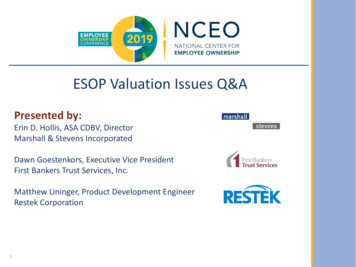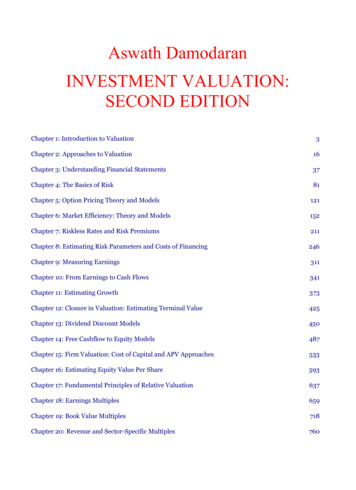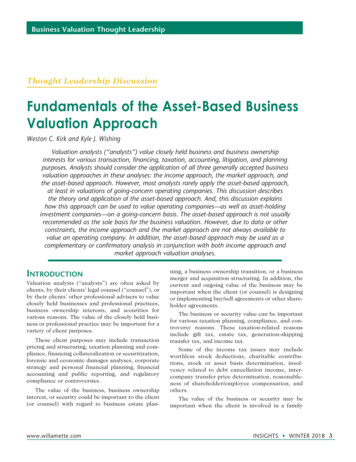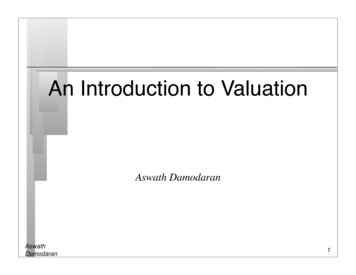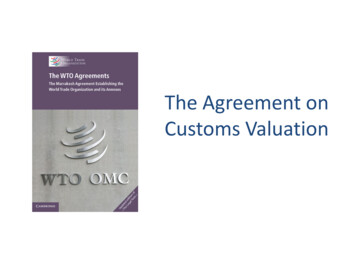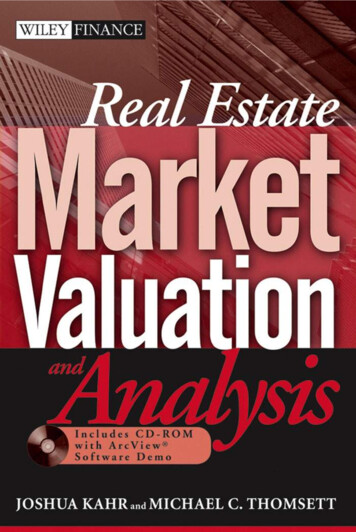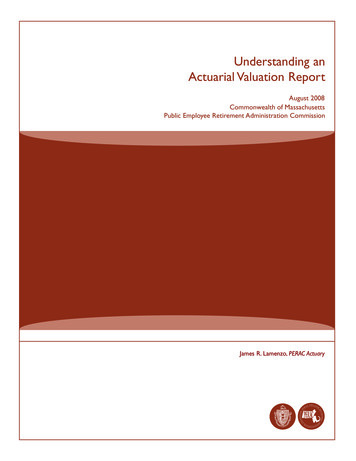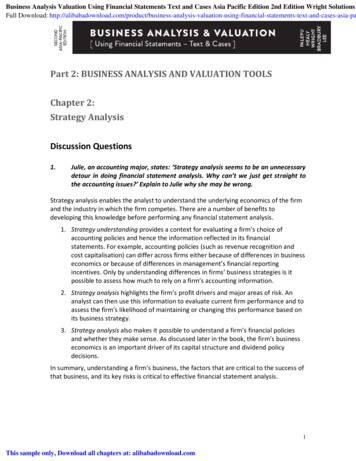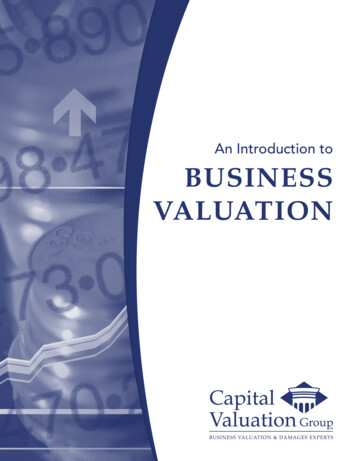
Transcription
An Introduction toBUSINESSVALUATION
Introduction to Business ValuationIf you own stock in a public corporation, you can readily determine its valueby going to The Wall Street Journal and finding the price at which the stock istrading.However, if you own stock or a member interest in a closely held company,you have no market reference to determine the equity's value.So, how can you determine the value of your closely held equity interest?The process Capital Valuation Group follows in valuing the equity of aclosely held business applies many of the same procedures used by thesecurities analyst and sophisticated investor in establishing the trading rangefor a publicly owned security. However, in most instances, there is no actualmarket transaction to test the value determined for the closely held equityinterest.With that in mind, you may wonder what the proper procedures are forestablishing the value of a closely held business enterprise or a specific blockof equity?The successful valuation of a closely held equity interest requires: Identifying the proposed use of the valuation conclusion Defining the term "value" based on the proposed use of the valuationconclusion Analyzing the business enterprise and its future business plan Pricing the business enterprise Analyzing the specific block of equity Pricing the specific block of equityEach of these topics is outlined in this introduction to the key concepts behindthe valuation of closely held businesses. This publication is meant to be anintroduction, not a comprehensive source in “how to value a business”. Theprofessional discipline of business valuation is a dynamic one. The theory ofvaluation is constantly being analyzed and modified, and this publication willbe updated as concepts evolve.Capital Valuation Group, Inc.An Introduction to Business Valuation1
Identifying the Proposed Use of the ValuationCapital Valuation Group values closely held equity for many differentreasons. For example, Someone is interested in buying all the outstanding equity of a closelyheld corporation. How much should the buyer pay for the equity? The owner of all the equity of the same corporation is gettingdivorced. The owner is also the President and key employee of thecompany. What is the value of this equity for purposes of the divorce?What is the value of this stock for purposes of dividing the maritalestate if the owner is going to continue owning and operating thebusiness after divorce? An individual dies owning all of the equity of the same company.What value should be placed on this equity interest for purposes offiling an estate tax return? A business owner is working on personal retirement planning andneeds to understand the true value of his or her business as well asways to increase value. A business owner has decided to sell to an Employee StockOwnership Plan (ESOP) so the employees keep their jobs and benefitfrom continuing to grow the company.Since all of these situations deal with equity of the same company, isn't thevalue of the equity the same in all five instances? You may be surprised tolearn that it is not. In fact, every business has many values, depending uponthe purpose of the valuation.More ThanOne CorrectValueA "real world" buyer of a closely held business must value both thecontinuing benefits of ownership under its own plan of operation and thebenefits of continued ownership to the seller in order to form a fundamentalpricing strategy to begin purchase negotiations.The "legal world" of hypothetical transactions and values attempts to simulatereal world events under the guidance of special definitions of the term "value"developed from statutes and case law history. These special definitionsdevelop as judges and juries seek fairness and equity for the parties at oddsover estate taxes, divorce, shareholder squeeze-outs, and condemnations.Capital Valuation Group, Inc.An Introduction to Business Valuation2
Defining the Term “Value”The value of a closely held block of equity is commonly considered its fairmarket value. "Fair market value" has been defined as the cash (or cashequivalent) price at which the equity would change hands between a willingbuyer and willing seller, neither being under any compulsion to buy or selland both having reasonable knowledge of relevant facts.The purpose or reason for undergoing the valuation affects the valueconclusion by its characterization of the willing buyer and seller in thiscommon definition. This is important because different buyers and sellersassign different values to a business and its equity.A "real world" buyer would assign a higher value to a business or its equity ifthat business were a good fit with the buyer's current business. In this way,the "best fit" buyer both increases the benefits and reduces the risk of thebusiness investment opportunity.On the other hand, a buyer who had no similar business, did not want tomanage the business purchased, and was concerned about the lack of liquidityin owning a closely held equity interest would pay far less for the samebusiness or its equity. This buyer would pay less because the risks are somuch greater than they are to the "best fit" buyer.The chart on the next page is a tool developed by Capital Valuation Group toillustrate the different relative values that different types of buyers would bewilling to pay for the equity in a closely held companyCapital Valuation Group, Inc.An Introduction to Business Valuation3
Capital Valuation Group, Inc.An Introduction to Business Valuation4
BargainingPositionThe terms "value" and "price" are not synonymous. Bargaining position is afunction of economic strength, knowledge, skill, and timing. As the diagrambelow illustrates, the price actually paid for a business enterprise has as muchto do with successful positioning as it does with the value delivered.Successful negotiation of price and terms under a sound strategic plan are asimportant as intrinsic value in the economic outcome of a business saletransaction.Characterizationof Buyer andSellerIn actual business sales, the buyer and seller seldom have equal bargainingpositions. The seller is often at a disadvantage because the businessenterprise must be sold - an owner and key employee has died, thebusiness is no longer competitive, the owner wishes to retire but has notdeveloped successor managers or owners. In these instances, the buyermay acquire the business at a price well below its value since the sellerdoes not have a strong bargaining position.If the valuation is prepared to assist in negotiations in an actual sale andpurchase of a business or its equity, the characterization of the buyer andseller is not difficult. In contrast, the characterization of the willing buyer andseller is more difficult - but equally as important - in a transaction in which anactual "sale" will not take place, such as a valuation for purposes of divorce,determining an estate tax, or retirement planning.Who is to be considered the seller and buyer for purposes of an estate taxvaluation or a divorce valuation? They are different in each circumstance andmay differ from state to state - depending on the law.Laws, regulations, and interpretive cases continue to modify these definitionsto fit our ever-changing economy, tax laws, and individual property rights.Capital Valuation Group, Inc.An Introduction to Business Valuation5
Analyzing the Business EnterpriseIs This aBusiness ora Career?The business enterprise being valued must be clearly defined and fullyanalyzed. Capital Valuation Group must first determine whether atransferable business exists. In some instances, the business enterprise mayactually be an individual's career, and there may be no business enterprise ofsaleable value beyond the individual's "tools of trade” or assets, such as aplumber’s truck, tools, and inventory.The business appraiser must ask two important questions to determine if thebusiness has transferable value beyond just the liquidation value of the assets.1. Would the business continue under new ownership or does the expertiseneeded to continue the business lie solely with the current owner?2. Does the business generate earnings after paying the owner(s) marketcompensation for their services to the business?If it is determined that a business exists apart from the owner's expertise andpersonal career, the appraiser must then determine what contributes value tothe business.Any business enterprise is only partially described by its financial statements.Accounting conventions employed in preparing standard business financialstatements are based upon "cost" (not market value) and focus on "tangible"properties (not intangible properties). Intellectual properties like software,patents or databases may be the most valuable property rights owned by abusiness but may not appear as an asset on its balance sheet. Appreciated realestate worth millions may only appear at its depreciated asset cost of a fewthousand dollars. This complexity illustrates why we cannot rely on simplemultiples of earnings when determining the value of a closely held business.While applying multiples of earnings can be meaningful in the world ofpublicly traded companies, privately owned businesses are far too diverse,even within the same industry to “apply a multiple”. Our definition of amultiple in the world of closely held business valuation is “a homemaderecipe for making a guess—somewhere between a mathematical formula anda shot in the dark.” Definitely not a reliable way to value a business.Capital Valuation Group, Inc.An Introduction to Business Valuation6
Building Blocks of ValueEvery transferable business enterprise is built of well-defined structural components. In the chartbelow, Capital Valuation Group illustrates some of these value components. These building blocksof value will be different for every business enterprise. The existing capacity of each block is asimportant as the seller's history of utilization of that capacity.Capital Valuation Group, Inc.An Introduction to Business Valuation7
Capacity andUtilizationThe structure of a business enterprise and its capacity to produce profitsmay yield significant value that cannot be seen in the financial statementsif current owners and managers have not fully exploited this capacity.Financial statements are prepared according to certain generally acceptedaccounting principles that are not intended to indicate the value of abusiness enterprise. Financial statements reflect only the historicalutilization of this capacity, whereas business valuation requires that thebusiness’s capacity for growth be quantified.In addition, the growing importance of services and technology and thedeclining emphasis on manufacturing in our economy are accompanied by adeclining importance of tangible assets and increasing importance ofintangible assets. In many business enterprises, the most significant buildingblocks of value are such intangible assets as: marketing and distribution systemspatents or other intellectual propertypersonnel having appropriate education, talent and experiencecomputer programs and databasesmanagement systemsThese value components are not readily identified from financial statementsand are only evident from a thorough understanding of the operations of thebusiness enterprise.ConsiderYourBusinessEnterpriseConsider your business enterprise for a moment: What are the valuable building blocks of your business? What do the financial statements for your business tell you about the Capital Valuation Group, Inc.historical utilization of these components of value?What is the earning capacity of these valuable business components?Do you have a business enterprise that is transferable to a buyer, or doyou have a career? (A career usually has few of the value componentsnoted in the pyramid graphic.)What defining characteristics make your business unique from yourcompetition and make your business "tick"?What is the plan for your business’s future?An Introduction to Business Valuation8
DynamicExternalConditions CanChange ValueQuicklyA business enterprise does not operate in a vacuum. It is affected by theeconomic conditions of its industry and market and by the economy ingeneral. The diagram below illustrates the ever-widening environment inwhich a business enterprise operates and which affects the value of thebusiness enterprise.A business enterprise is dynamic and changes over time along with changesin its environment. Similarly, the value of a business enterprise changes overtime.Capital Valuation Group, Inc.An Introduction to Business Valuation9
Pricing the Business EnterpriseA thorough analysis of a business enterprise provides information for pricingthe business enterprise. Common pricing methods under the three approachesto value include:IncomeApproach toValueCapitalization of earnings - The price obtained by applying a factor to abusiness enterprise's established annual earnings base that reflects: the risk-free rate of return available to investors in United States Treasuryobligations the additional rate of return required by the particular risks associatedwith the business enterprise being priced less the growth rate that can be expected in the business enterprise'sannual earnings in future yearsNote: This method only applies if a business’s future earnings are expected tobe unchanged from the historical earnings being capitalized which is rarelythe case.Discounted cash flow - The price obtained by projecting the expected cashflows produced by the business enterprise during the investment period anddetermining its present value using a discount rate that reflects:the risk-free rate of return available to investors in United StatesTreasury obligations the additional rate of return required by the particular risks associatedwith the business enterprise being priced. The discount rate differs from the factor applied in the capitalization ofearnings pricing method because the projected cash flows directly reflectexpected growth in annual earnings.MarketApproach toValueGuideline Public Company - The price indicated by applying pricingratios derived from publicly traded companies that are similar to the closelyheld business being priced. Pricing ratios for the guideline companies arederived from stock price information related to appropriate financial data.These pricing ratios are then applied to similar financial data of the closelyheld business to arrive at an indicated price of the business as if it were tradedas a series of publicly traded minority shares of stock. Common pricingmultiples include: Price/earnings Price/sales Price/cash flow Price/book valueCapital Valuation Group, Inc.An Introduction to Business Valuation10
The prices indicated using this method must be adjusted to reflect the fact thatthe stock of the closely held business is not publicly traded (marketable in 3days) and that the ownership interest in the business being valued may be acontrolling position and not a minority one.Guideline Company Transactions - The price indicated by applyingpricing information obtained from sales of similar closely held businessenterprises.Formula - The price obtained by applying a "rule of thumb" specific to aparticular industry.Previous transactions – The price indicated by previous arm’s lengthtransactions in the subject company’s equity.Asset Approachto ValueOrderly liquidation - The dollar amount realized from sale of the businessenterprise's assets in an orderly manner (not an auction) followed by paymentof all debt. This pricing method usually assumes that the business will notcontinue as an on-going business, which may mean that any intangible valueassociated with the business will be lost.Replacement cost - The dollar amount necessary to reproduce the businessenterprise's tangible and intangible assets and liabilities as part of an on-goingbusiness.Capital Valuation Group, Inc.An Introduction to Business Valuation11
Assignment ofThese valuation methods determine the price of an entire business enterprise,Buyer's Total Price which is made up of such “building blocks” as key people, facilities,customer and supplier relationships, product and service lines, and creditrelationships. In order to own and enjoy the full benefit of such an enterprise,a buyer needs reasonable assurance that all of these components will bedelivered by the seller and remain with the buyer. It is not unusual for amajor portion of the buyer's purchase price for the business enterprise to godirectly to key people for their assurance of continued services and noncompete covenants.In an actual sale of a business enterprise, a buyer will only be willing to paythe established business enterprise price to the equity holders if the buyer canobtain full enjoyment of the business enterprise's value. A buyer would notpay this price if a key employee will not continue with the business or thesellers are free to compete with the buyer after the sale.As the diagram below illustrates, portions of the total enterprise price mayhave to be assigned to certain individuals to assure their continuedcooperation or non-competition with the buyer. The balance of the totalbusiness enterprise price is assigned to the equity in the business enterprise.Capital Valuation Group, Inc.An Introduction to Business Valuation12
Analyzing a Block of EquityIf an individual owns one hundred percent of the equity of a businessenterprise, each share is usually assigned a pro rata portion of the total equityvalue of the business enterprise.If the enterprise is owned by a number of owners, each owner’s block ofequity may carry a very different value per share or member interest. The keyto the value of a particular block of equity relates to the degree of "control"that block may have over key business decisions. As the diagram on thefollowing page illustrates, the value of a block of equity in a businessenterprise depends on the influence that block of equity has in the operationsand strategy of the total business enterprise.The equity being valued must be thoroughly analyzed, since the value of aspecific ownership interest in a business enterprise reflects the rights of andrestrictions on, the equity owned.The analysis of the equity must consider such factors as:Capital Valuation Group, Inc. the voting rights of the equity relating to such matters as: declaring cash dividends/distributions electing directors and officers selling or reorganizing the business enterprise or its assets hiring, firing, and setting salaries setting general business policies preference rights over other classes of equity relating to: distribution of cash dividends/distributions from earnings distribution of liquidation proceeds voting rights transfer rights or restrictions reflected in: "buy-sell" or other shareholder agreements with the businessenterprise or other individual owner which restrict the freetransfer of the equity, or establish a set price for the equity ifcertain events occur "options" held by the company or other owners to buy theowner’s stock at a set price if certain events occur "puts" held by the owner which protect the value of the equityby allowing the owner to sell the equity at a set price if certainevents occur "income tax election" availability for special corporate returnconsolidation or avoidance of double taxation at corporatelevel ("S" election or other pass-through entity).An Introduction to Business Valuation13
Capital Valuation Group, Inc.An Introduction to Business Valuation14
Pricing the Specific Block of EquityOnce the value of the business enterprise has been determined, and anynecessary allocations of value have been made to key employees for theirnon-compete and transitional service agreements, the final step is to price theequity of the closely held business enterprise.A thorough analysis of the equity of a business enterprise providesinformation for pricing this equity. Common pricing methods include:Discounted pro rata value - The value determined for one hundred percentof the equity of the business enterprise is allocated pro rata among the equityoutstanding.If the particular block of equity being valued cannot control the businessenterprise, a discount for lack of control is applied to the pro rata value toreflect the lack of control.If the value of the entire business enterprise was determined by reference topublicly traded comparable companies' stock, a discount for lack ofmarketability is applied to the pro rata value to reflect the illiquidity of theclosely held equity.Contractual value - Apply pricing methods contained in contractualagreements with the business enterprise or other equity holders. Theseagreements should be analyzed to determine if their purpose is comparable tothe purpose for this valuation, since valuations for different purposes willproduce different values.Prior transfers - Apply prices identified from prior transfers of similarblocks of equity in the business enterprise. Again, the purpose for theseearlier transfers must be examined to determine whether the price isapplicable to the valuation at hand.Dividend discount model - This method allows the analyst to value theequity of the business enterprise directly, without first valuing the businessenterprise. However, it is still necessary to analyze thoroughly the businessenterprise before proceeding to this step. This method determines the valueof a share of equity by projecting the expected dividends/distributions to bepaid to equity holders produced by the business enterprise and determiningtheir present value using a discount rate that reflects: the risk-free rate of return available to investors in United StatesTreasury obligationsCapital Valuation Group, Inc.An Introduction to Business Valuation15
the equity risk premium that represents the differences between thehistorical stock market returns and risk-free security returns the size premium reflecting the fact that the equities of smallercompanies are riskier than those of larger ones the industry risk premium reflecting the volatility or risk associatedwith a specific industry the additional rate of return required by the particular risks associatedwith the business enterprise and the stock being valuedIn ConclusionEach step in the valuation process requires the insight and input of ownersand managers to assure a meaningful valuation conclusion. The process itselfcan be as informative as the value conclusion to all who participate in thegathering of information and its analysis.Most important, however, all appraisals must reflect judgment and commonsense. An appraisal of a closely held business enterprise is not merely anacademic exercise. Real businesses and individuals are involved, and theappraiser must be careful to reflect the judgments that real business ownersand investors would apply in determining the fair market value for a businessenterprise or its equity.Capital Valuation Group, Inc.An Introduction to Business Valuation16
Common Business Valuation TerminologyAdjusted Book Value The book value that results after one or more asset or liability amounts areadded, deleted, or changed from the respective book amounts.Annuity Investment that produces a level stream of cash flows for a number of periods.Appraisal The act or process of determining value. It is synonymous with valuation.Appraisal Approach A general way of determining value using one or more specific appraisalmethods. (See Asset Approach, Market Approach, and Income Approach definitions.)Appraisal Date The date as of which the appraiser's opinion of value applies.Appraisal Method Within approaches, a specific way to determine value.Appraisal Procedure The act, manner and technique of performing the steps of an appraisalmethod.Appraised Value The appraiser's opinion or determination of value.Asset Approach A general way of determining a value indication of a business's assets and/orequity interest using one or more methods based directly on the value of the assets of the businessless liabilities.Book Value1. With respect to assets, the capitalized cost of an asset less accumulated depreciation,depletion or amortization as it appears on the books of account of the enterprise.2. With respect to a business enterprise, the difference between total assets (net of depreciation,depletion and amortization) and total liabilities of an enterprise as they appear on the balancesheet. It is synonymous with net book value, net worth and shareholders' equity.Business Appraiser A person who by education, training and experience is qualified to make anappraisal of a business enterprise and/or its intangible assets.Business Enterprise A commercial, industrial or service organization pursuing an economicactivity.Business Valuation The act or process of arriving at an opinion or determination of the value of abusiness enterprise or an interest therein.Capitalization1. The conversion of income into value.2. The capital structure of a business enterprise.3. The recognition of an expenditure as a capital asset rather than a period expense.Capital Valuation Group, Inc.An Introduction to Business Valuation17
Capitalization Factor Any multiple or divisor used to convert income into value.Capitalization Rate Any divisor (usually expressed as a percentage) that is used to convert incomeinto value.Capital Structure The composition of the invested capital (debt plus equity).Cash Flow Net income plus depreciation and other non-cash charges.Control The power to direct the management and policies of an enterprise.Control Premium The additional value inherent in the control interest, as contrasted to a minorityinterest, which reflects its power of control.Corporation A legal entity with a perpetual existence where ownership is represented by stockcertificates. Shareholders have limited personal liability for the debt and obligations of the business.Covenant Not to Compete A contractual agreement whereby an individual or a corporationagrees not to enter into competition against another for a specified period of time.Discount Factor Present value of one dollar received at a stated future date.Discount Rate A rate of return used to convert a monetary sum, payable or receivable in the futureinto present value.Economic Life The period over which property may be profitably used.Employee Stock Ownership Plan (ESOP) An employee benefit plan whose primary investmentgoal is to purchase and own the equity of the sponsoring company.Enterprise See Business enterprise.Equity The owners' interest in property after deduction of all liabilities.Fair Market Value The amount at which property would change hands between a willing sellerand a willing buyer when neither is acting under compulsion and when both have reasonableknowledge of the relevant facts.Going Concern An operating business enterprise.Going Concern Value1. The value of an enterprise, or an interest therein, as a going concern.2. Intangible elements of value in a business enterprise resulting from factors such as having atrained workforce, an operational plant, and the necessary licenses, systems and proceduresin place.Capital Valuation Group, Inc.An Introduction to Business Valuation18
Goodwill That intangible asset which arises as a result of name, reputation, customer patronage,location, products and similar factors that have not been separately identified and/or valued butwhich generate economic benefits.Income Approach A general way of determining a value indication of a business or equity interestusing one or more methods wherein a value is determined by converting anticipated benefits topresent value or date of valuation.Invested Capital The sum of the debt and equity in an enterprise on a long-term basis.Limited Liability Company (LLC) The LLC is a hybrid between a partnership and acorporation, combining the limited liability advantage of a corporation with the flow-throughtax status of an S corporation or sole proprietorship but without having to conform to the Scorporation restrictions.Limited Liability Partnership (LLP) A type of company that provides liability protection for allgeneral partners as well as management rights in the business. Most commonly used in professionalpractices, an LLP offers, in most cases, the same limited liability enjoyed by a corporation, with theflow-through tax status of a partnership.Majority Ownership position greater than 50% of the voting interest in an enterprise.Market Approach A general way of determining a value indication of a business or equity interestusing one or more methods that compares the subject to similar investments that have been sold.Marketability Discount An amount or percentage deducted from an equity interest to reflect lackof marketability.Minority Discount The reduction, from the pro rata share of the value of the entire business,which reflects the absence of the power of control.Net Assets Total assets less total liabilities.Net Income Revenues less expenses, including taxes.Opportunity cost of capital (hurdle rate, cost of capital) Expected return that is forgone byinvesting in one investment opportunity or project rather than in comparable alternative investmentopportunities.Capital Valuation Group, Inc.An Introduction to Business Valuation19
Partnership1. Made up of two or more individuals, where each partner has the authority to act on behalf ofthe business, and each partner has unlimited personal liability for all obligations of thebusiness. Partnerships have an uncertain life and can be terminated by any partner(partnership at will).2. Limited Partnership – Type of partnership comprised of one or more general partners whomanage the business and who are personally liable for partnership debts, and one or morelimited partners who contribute capital and share in profits but who take no part in runningthe business and incur no liability with
An Introduction to Business Valuation 1 Introduction to Business Valuation If you own stock in a public corporation, you can readily determine its value by going to The Wall Street Journal and finding the price at which the stock is trading. However, if you
